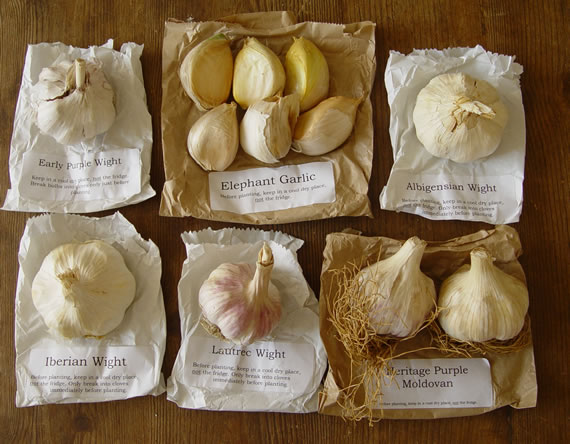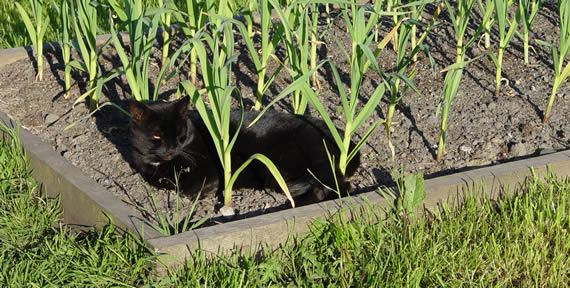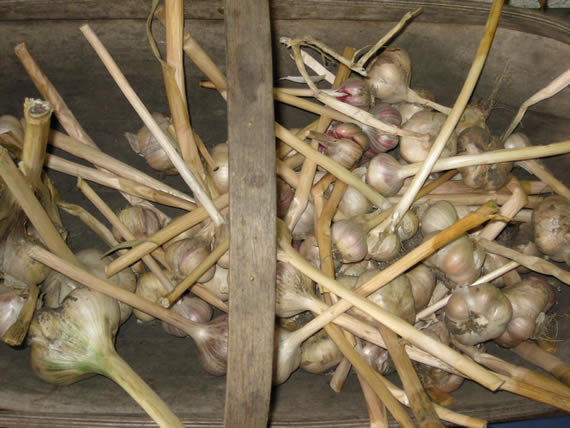Garlic Growing
Garlic (Allium sativum) is one of the easiest and most satisfying crops you can grow. If you're a beginner, or have a limited amount of space, garlic is the thing for you. It's reputed to be a good companion plant for roses and other shrubs, supposedly detering greenfly. In my experience it does seem to help, but isn't a guarantee against the green menace.
Buy good stock
For best results start with a head of garlic bought from a reputable grower, or from a garden centre or gardening catalogue.
 Garlic varieties
Garlic varieties
There are many varieties available, so experiment and trying growing at least three or four to find those which you prefer and which do best in local conditions. We recommend these varieties, available from most other gardening and growing merchants:
- Lautrec wight garlic (hardnecked)
- Solent wight garlic (softnecked)
- Elephant garlic
You can use garlic bought in a supermarket at a pinch, but the crop is very likely to be inferior.
When to plant garlic
Traditionally garlic is planted on the shortest day of the year and harvested on the longest day of the year - I've personally found December to be fine for planting, but in most years it takes until mid-July for the heads to be ready for lifting. Garlic doesn't need a very rich soil, but does prefer a free draining soil - if yours is heavy dig in some sand or plenty of organic matter like compost before planting.
Break the head into individual cloves, and plant these about 2 inches deep, 6 inches apart, in rows 6 inches apart (i.e. squares). For some of the jumbo varieties you'll need to increase this spacing, but for your standard garlic this will be fine.
Plant with the flat end down the way - the new green shoot will emerge from the pointy end (a horticultural term) and by spring you'll have a good few inches of growth. If you are troubled by crows or pigeons you may wish to net your newly planted cloves as I do, as the birds may lift them just for fun.
 Garlic growing, under guard!
Garlic growing, under guard!
Otherwise garlic takes very little looking after. Keep weeds down by judicious use of your hoe, and water in extended dry spells.
Harvesting garlic
You'll know when the garlic is ready to lift because the tops turn yellow and start to dry out. Once more than half of your crop has done this lift them all gently with a fork, remove any excess soil from the hairy roots and leave them somewhere to dry thoroughly - hanging them inside or out in a sheltered spot is the best way.
 Dried garlic, ready for storage
Dried garlic, ready for storage
Once they are dried you can plait them into braided lengths and store them just about anywhere that isn't too moist or warm. Remember to keep some of the fattest cloves to plant next year - you need never buy supermarket garlic again.
- Previous « Why Grow Vegetables?
- Next Growing potatoes »

About Dan Champion
A self-confessed geek, Dan would spend 20 hours per day in front of a computer if he didn't live on a 12-acre smallholding in the east of Scotland (and if his wife would let him). He also built this website.
Further Reading
 Vegetable Growing Month-by-month John Harrison |  Kitchen Garden Estate: Self-sufficiency Inspired by Country Estates of the Past Helene Gammack |  Fruit and Vegetables for Scotland: A Practical Guide and History Kenneth Cox and Caroline Beaton |  The Vegetable and Herb Expert Dr D G Hessayon |  Comfrey: Past, Present and Future Lawrence D. Hills |




















